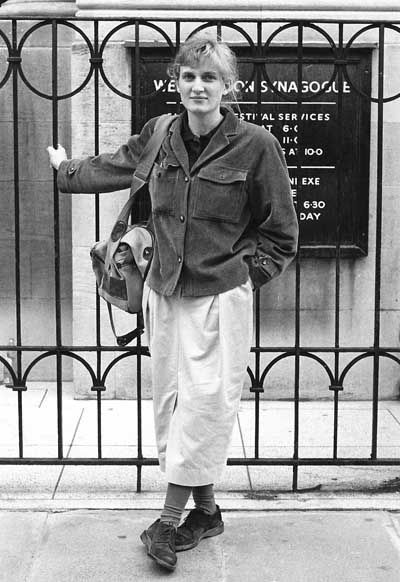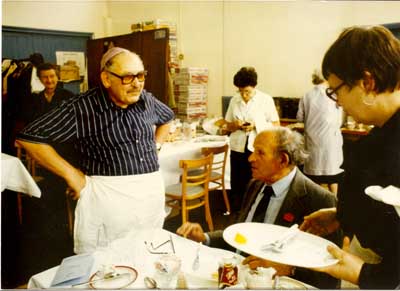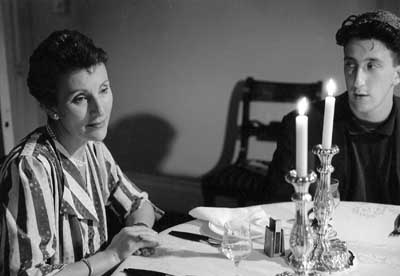 Naomi Gryn and Chris Plevin filming The Sabbath Bride, London. 1987. Photograph by Sharon Chazan.
Naomi Gryn and Chris Plevin filming The Sabbath Bride, London. 1987. Photograph by Sharon Chazan.
When I mentioned to a neighbour that I was making a film about the Jewish Sabbath, she told me that her father, a photography tutor, had a talented student, Sharon Chazan, who was working on Jewish themes and she offered to introduce us.
Sharon had a halo of yellow hair, a warm intelligence, and even though she was still in her early 20s, she’d already accumulated a wonderful portfolio of work. She was breathtakingly gutsy: she’d followed home strange men in Cairo and photographed Hell’s Angels near her college in Newport. But when her mother, Valerie, bought a flat in Wapping, Sharon became fascinated by the fast-shrinking Jewish community in London’s East End and though it might have seemed much tamer than some of her earlier themes, she began to document its remnants in a series she called Yids.
We bonded in a flash and Sharon agreed to take stills on my shoot. On a low-budget documentary for Channel 4, it was something of a luxury to have a dedicated stills photographer, but Sharon was a great asset, introducing me to some of the most vibrant characters in the film.
One evening, we were shooting in the Golders Green home of Rabbi Jonathan Sacks – Britain’s future Chief Rabbi. When I got home there was an anxious message on my answer phone from Sharon’s mother. ‘What gives?’ I asked Sharon when we next met. Apparently one of the subjects of her Yids series, Moshe Drukash, an elderly Polish Jew, was stalking her and Sharon's mother was concerned. Her mother was right to be worried.

 Late one Sunday evening, I was in the cutting room watching the rushes of a Torah procession in Stamford Hill which I planned to use as The Sabbath Bride’s opening scene. Unexpectedly, Sharon appeared on screen and that reminded me to phone her to find out what had happened to that Drukash chap. I’d call in the morning….
Late one Sunday evening, I was in the cutting room watching the rushes of a Torah procession in Stamford Hill which I planned to use as The Sabbath Bride’s opening scene. Unexpectedly, Sharon appeared on screen and that reminded me to phone her to find out what had happened to that Drukash chap. I’d call in the morning….
But, instead, Valerie Chazan rang me. Sharon had been shot dead by Drukash, who’d then killed himself. Could I help her organise her daughter’s funeral?
I dedicated the film to Sharon’s memory and still treasure the photographs that she took for me, the contact sheets carefully marked with her favourite images. I often think about Sharon and wonder how she might have flowered, but it’s the memory of her mother screaming with injustice at Sharon’s graveside that will haunt me for the rest of my life.